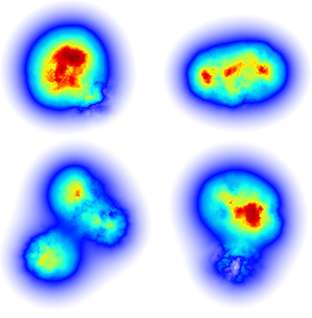Model identifies a high degree of fluctuations in gluons as essential to explaining proton structure

Gluons, the glue-like particles that ordinarily bind subatomic quarks within the protons and neutrons that make up atomic nuclei, appear to play an important role in establishing key properties of matter. But right now, no one can see how gluons are distributed within individual protons and nuclei. Recent experiments at Brookhaven National Lab and the European Center for Nuclear Research (CERN) suggest that the arrangement of these particles within a proton fluctuates strongly. This means that while, on average, a proton is close to spherical, if we were to take snapshots of a proton in time, each of them would look dramatically different. Brookhaven nuclear theorists have developed a model of gluon fluctuations that is consistent with previous measurements. The model allows them to interpret the new data from nuclear collision experiments as snapshots of what a proton really looks like at any given point in time.
Nuclear physicists want to study the properties of the nuclear matter in the nucleus and how it is changed by high-energy collisions. To do this they measure the patterns of particles that fly out from collisions of protons with heavy nuclei in particle colliders. These colliders include the Relativistic Heavy Ion Collider (RHIC) at Brookhaven National Laboratory and the Large Hadron Collider (LHC) at Europe's CERN laboratory. To understand more about the nuclear matter they need to know what the proton looked like when the collision happened. In experiments at these facilities, where particles are accelerated to high energies, the gluons are virtual particles that continuously split and recombine, essentially flickering in and out of existence like the light of fireflies blinking on and off in the nighttime sky. Because scientists can't see this flicker directly, they need a model that accurately describes the fluctuating behavior. Understanding the flickering lets physicists interpret results from these experiments to better understand the internal structure of protons and better explain our world.
Experimental results from RHIC and the LHC suggest that protons are much more complex than a simple arrangement of three quarks held together by gluons. Understanding how protons interact when they collide with larger nuclei requires knowing the geometry of the proton just before the collision—whether it is round or more irregular, for example. Exploring the internal structure of the proton is also a fundamental research endeavor for nuclear physicists.
While scientists know how large the average gluon density is inside a proton, they do not know exactly where the gluons are located inside the larger particle or how large the fluctuations in shape and gluon distribution might be. Without the ability to see inside the proton, the scientists developed a mathematical model to represent a variety of arrangements of gluons. The scientists then tested the model by comparing its predictions with experimental data from an accelerator in Germany. They found that including a high degree of gluon fluctuations in their model fit the data best. The scientists are now looking to apply this knowledge to the proton-nucleus collisions at RHIC and the LHC. If this model can successfully describe these experiments, scientists will be able to use some key observables from the experiments as measures of the proton shape at the time of collision.
More information: Heikki Mäntysaari et al. Revealing proton shape fluctuations with incoherent diffraction at high energy, Physical Review D (2016). DOI: 10.1103/physrevd.94.034042
Heikki Mäntysaari et al. Evidence of Strong Proton Shape Fluctuations from Incoherent Diffraction, Physical Review Letters (2016). DOI: 10.1103/physrevlett.117.052301
Journal information: Physical Review Letters , Physical Review D
Provided by US Department of Energy





















